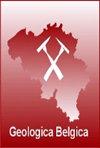The rise and fall of Late Devonian (Frasnian) trilobites from Belgium: taxonomy, biostratigraphy and events
IF 0.7
4区 地球科学
Q2 GEOLOGY
引用次数: 7
Abstract
1. Introduction The Frasnian was a period of recurrent global eustatic perturbations that had already commenced in the Middle Devonian and led to major faunal crises. Frasnian trilobites, encompassing exclusively benthic and endobenthic inhabitants of the continental shelf, suffered consecutive blows from the worldwide “drowning” of reef ecosystems and a decline of the shallow water environments to which they were confined (Feist, 1991, 1995). The latest Frasnian Kellwasser Event, though not by itself responsible for the demise of Frasnian trilobites, was the “coup de grâce” for many families. This event and its effects on trilobites have been the focus of investigations at various sections located in Germany, France, Morocco and NW Australia, among other countries (e.g. Becker et al., 1989; Feist & Schindler, 1994; Feist, 2002; McNamara & Feist, 2016). Frasnian trilobites from Belgium were described mainly in the monograph on Late Devonian trilobites of Richter & Richter (1926) and in van Viersen & Bignon (2011) and van Viersen & Prescher (2011). Bignon & Cronier (2015) analysed faunal dynamics of Devonian trilobites from Belgium and northern France and recognised two poorly diversified associations in the Frasnian: the Scutellum–Goldius association which they considered to be restricted to reef environments, and the Bradocryphaeus association (Bradocryphaeus, Otarion, Heliopyge) of Cronier & van Viersen (2007) which occurs in lateral shales and limestones below fair-weather比利时晚泥盆纪(弗拉斯纪)三叶虫的兴亡:分类、生物地层学和事件
1. 弗拉斯纪是一个周期性的全球波动扰动时期,早在中泥盆纪就开始了,并导致了主要的动物危机。Frasnian三叶虫,仅包括大陆架的底栖动物和底栖动物,受到了世界范围内珊瑚礁生态系统“淹没”和它们所局限的浅水环境下降的连续打击(Feist, 1991,1995)。最近的Frasnian Kellwasser事件,虽然本身并不是导致Frasnian三叶虫灭亡的原因,但对许多家庭来说却是“重大政变”。这一事件及其对三叶虫的影响一直是在德国、法国、摩洛哥和澳大利亚西北部等国家的不同地区进行调查的重点(例如Becker等人,1989;Feist & Schindler, 1994;无用的人,2002;McNamara & Feist, 2016)。来自比利时的Frasnian三叶虫主要见于Richter & Richter(1926)的晚泥盆纪三叶虫专著、van Viersen & Bignon(2011)和van Viersen & Prescher(2011)。Bignon & Cronier(2015)分析了来自比利时和法国北部的泥盆纪三叶虫的动物动态,并在Frasnian中发现了两个多样性较差的组合:Scutellum-Goldius组合,他们认为这种组合仅限于珊瑚礁环境,以及Cronier & van Viersen(2007)的Bradocryphaeus组合(Bradocryphaeus, Otarion, Heliopyge),这种组合出现在天气良好的横向页岩和石灰岩中
本文章由计算机程序翻译,如有差异,请以英文原文为准。
求助全文
约1分钟内获得全文
求助全文
来源期刊

Geologica Belgica
地学-地质学
CiteScore
4.70
自引率
27.80%
发文量
8
审稿时长
>12 weeks
期刊介绍:
Geologica Belgica is a Belgian journal that welcomes papers concerning all aspects of the earth sciences, with a particular emphasis on the regional geology of Belgium, North West Europe and central Africa. Papers not dedicated to the geology of Belgium, North West Europe and central Africa are only accepted when one of the authors is linked to a Belgian University or Institution. Thematic issues are highly appreciated. In this case, guest editors take in charge the selection of the manuscripts and the subject of the papers can be enlarged. The journal is in open access.
Submitted manuscripts should be concise, presenting material not previously published. The journal also encourages the publication of papers from Belgian junior authors. Short letters are accepted. Papers written in English are preferred. Each mansucript will be reviewed by at least two reviewers.
 求助内容:
求助内容: 应助结果提醒方式:
应助结果提醒方式:


